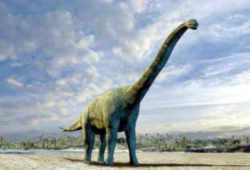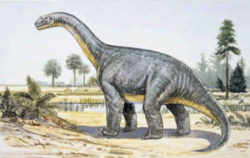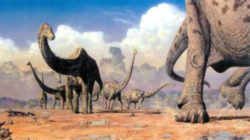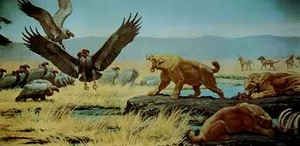Maryland State Dinosaur
Sauropod Dinosaur

(Astrodon johnstoni)
Adopted on October 1, 1998.
Because of the dinosaur historical importance to the state, the Maryland General Assembly passed House Bill 1170 and Senate Bill 520 by wide margins, and the governor signed them into law on October 1, 1998, giving Maryland its own state dinosaur, the Sauropod Dinosaur, (Astrodon johnstoni.) The Astrodon lived in Maryland during the Early Cretaceous period, from 95 to 130 million years ago.
Maryland State Dinosaur: Sauropod Dinosaur

Astrodon is a genus of large herbivorous sauropod dinosaur, related to Brachiosaurus, that lived in what is now the eastern United States during the Early Cretaceous period. Its fossils have been found in the Arundel Formation, which has been dated through palynomorphs to the Aptian-Albian boundary, about 112 million years ago. Adults are estimated to have been more than 9 m (30 ft) high and 15 to 18 m (50 to 60 ft) long.
Astrodon was a large-bodied, long-necked dinosaur which lived during the Early Cretaceous, 130 - 95 million years ago. It is found in an area of coastal Maryland thought to have been swampy, but may not have actually lived in the swamp - perhaps its bones washed into the swamp via a river after the dinosaur died somewhere inland.
Astrodon means "star tooth" and derives from the fossils found in 1858 by Philip Tyson, then Maryland's State Agricultural Chemist. His discovery
of two teeth in the Arundel Clay near Muirkirk in Prince George's County was one of the earliest dinosaur finds in this country and the first in Maryland.
Tyson gave the teeth to a local doctor and dentist Christopher Johnston, who sliced a tooth into cross sections, discovering a star pattern. In his
1859 article for the American Journal of Dental Science, Dr. Johnston called the species Astrodon.
Astrodons were sauropods ("lizard-hip"). These large dinosaurs weighed up to 20 tons. They had small heads, long necks, and long tails. Strong, solid
legs supported their rounded bodies. Adult Astrodons could be 50 to 60 feet long, and more than 30 feet tall. They were herbivorous, probably feeding
on conifers, ferns, and other plants
State Dinosaur Designated by Maryland Officials
By Marquita Smith
Capital News Service
Friday, April 3, 1998
 ANNAPOLIS - It took
110 million years, and some help from a group of Maryland students who lobbied on its behalf, but the House gave final approval Friday to a bill naming
Astrodon Johnstoni the official state dinosaur.
ANNAPOLIS - It took
110 million years, and some help from a group of Maryland students who lobbied on its behalf, but the House gave final approval Friday to a bill naming
Astrodon Johnstoni the official state dinosaur.
The House voted 120-12 with no discussion to approve a Senate bill giving the dinosaur his due - after all, he is the first Maryland citizen, said
Del. Joan Pitkin, D-Prince George's.
Besides educating children, naming a state dinosaur has a few other benefits, said Pitkin. Think license plates, lunch boxes and T-shirts - there could
be something for everyone, she said.
The big bucks that Pitkin sees coming from an official state dinosaur could be used to help fund a dinosaur park or museum. New Jersey saw similar
benefits when it named Hadrosaurus Foulkii - better known there as Hattie - its official dinosaur in 1991, she said.
No one spoke in opposition Friday to the dinosaur bill - a few even applauded and cheered before the vote. It was far different from 1993, when a move
to make Astrodon Johnstoni the state dinosaur failed in the House by two votes.
This year, the bill had help from elementary students, who came to Annapolis in March to try to persuade lawmakers to name a state dinosaur in Maryland.
The students worked hard, said Pitkin.
"They were the youngest lobbyists I've met," said Pitkin, who was a co-sponsor of a House version of the dinosaur bill that is now working its way
through the Senate.
The House vote Friday sends the Senate version of the bill to Gov. Parris Glendening for his signature.
Pitkin and other supporters of the bill said designating Astrodon Johnstoni as the state dinosaur would help educate children about prehistoric life
in Maryland.
"He was a plant eater and he loved water," she said.
Children will learn that Astrodon Johnstoni was a type of brachiosaur that resembled a cross between an elephant and a giraffe.
The dinosaur's bones were first discovered in Laurel. The Prince George's County site where scientists found many of the fossils will soon become a
museum and historical park, she said.
"We are often required to review very serious issues when it comes to children and education," said Pitkin, explaining that the bill was of a lighter
nature.
But it was not frivolous, she said.
Pitkin, who has nine grandchildren, said if they remember nothing else she's done this session, they will not forget that she helped to get them a
state dinosaur.
Copyright © 2001 and 2002 University of Maryland College of Journalism
Maryland Law
The law designating the Sauropod dinosaur as the official Delaware state dinosaur is found in the Maryland Statutes, Title 13, Section 13-316
STATE GOVERNMMENT
TITLE 13. EMBLEMS; COMMEMORATIVE DAYS; MANUAL.
SUBTITLE 3. ADDITIONAL EMBLEMS; DESIGNATIONS
SECTION 13-304.
§13-316.
The Astrodon johnstoni is the State dinosaur.
Taxonomic Hierarchy: Sauropod Dinosaur
Kingdom: AnimaliaPhylum: Chordata
Clade: Dinosauria
Suborder: Sauropodomorpha
Clade: Titanosauriformes
Family: Pleurocoelidae Marsh, 1888
Genus: AstrodonJohnston, 1859
Species: A. johnstoni

Some states that lack a "state fossil" have nevertheless singled out a fossil for formal designation such as a state dinosaur, rock, gem or stone.







